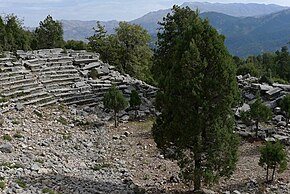Oenoanda
| Οινόανδα (Greek) | |

The Greco-Roman theatre in Oenoanda
|
|
| Alternate name | Oinoanda |
|---|---|
| Location | İncealiler, Muğla Province, Turkey |
| Region | Lycia |
| Coordinates | 36°48′33″N 29°32′59″E / 36.80917°N 29.54972°ECoordinates: 36°48′33″N 29°32′59″E / 36.80917°N 29.54972°E |
| Type | Settlement |
| History | |
| Associated with | Diogenes |
Oenoanda or Oinoanda (Greek: τὰ Οἰνόανδα) was an ancient Greek city in Lycia, in the upper valley of the River Xanthus. It is noted for the philosophical inscription by the Epicurean, Diogenes of Oenoanda. The ruins of the city lie west of the modern village İncealiler in the Fethiye district of Muğla Province, Turkey, which partly overlies the ancient site.
The early history of the settlement is obscure, in spite of an exploratory survey carried out, with permission of the Turkish authorities, by the British Institute at Ankara (BIAA) in 1974–76. It seems that Oinoanda became a colony of Termessos about 200-190 BC and was also called Termessos Minor (or Termessos i pros Oinoanda). Oenoanda was the most southerly of the Kibyran Tetrapoleis in the Hellenistic Period, which was dissolved by L. Licinius Murena in 84 BCE, whereupon Oenoanda became part of the koinon of Lycia, as its inscriptions abundantly demonstrate.
Diogenes carved a summary of the philosophy of Epicurus onto a portico wall, which originally extended about 80 meters. The inscription sets out Epicurus' teachings on physics, epistemology, and ethics. It was originally about 25,000 words long and filled 260 square meters of wall space. The inscription has been assigned on epigraphic grounds to the Hadrianic period, 117–138 CE. The stoa was dismantled in the second half of the third century CE to make room for a defensive wall; previously the site had been undefended.
...
Wikipedia

